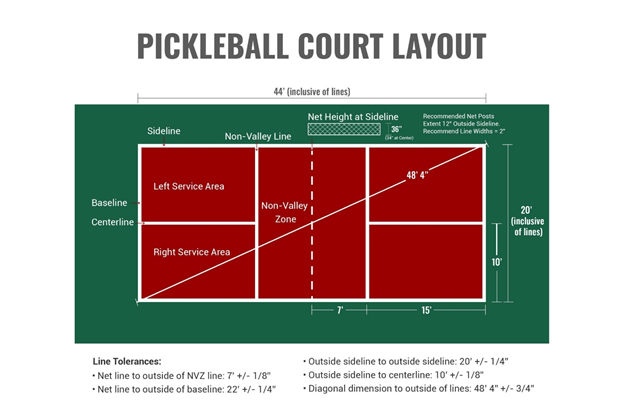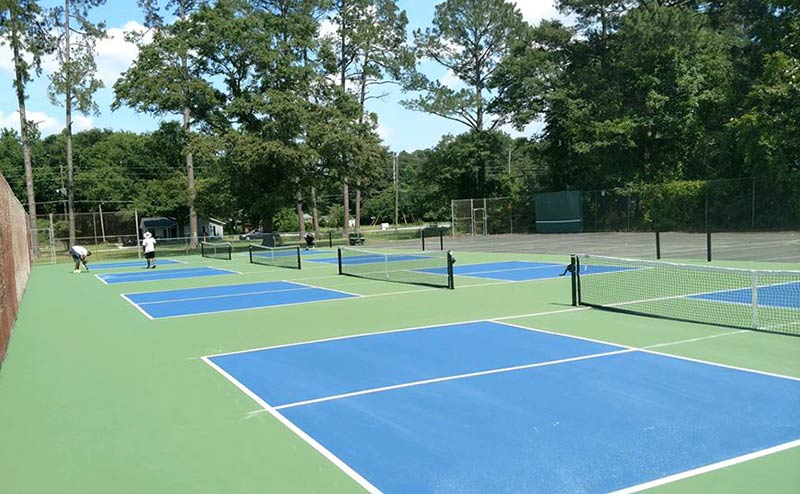Indoor and Outside Pickleball Court Construction Providers
Indoor and Outside Pickleball Court Construction Providers
Blog Article
Sustainable Practices in Pickleball Court Building You Must Know
As the popularity of pickleball proceeds to climb, so as well does the demand for lasting practices in court building. This strategy not just addresses ecological worries yet additionally enhances the longevity and capability of the courts. From choosing environmentally friendly products to implementing efficient drainage and energy-saving illumination remedies, there are countless methods to take into consideration. Yet, the influence of these techniques prolongs much past the court itself. Recognizing how each element adds to an extra sustainable future invites additionally expedition right into the elaborate balance between recreational development and environmental stewardship.
Choosing Eco-Friendly Products
Choosing environment-friendly materials is an important action in the building and construction of sustainable pickleball courts. The option of sustainable materials not just decreases environmental effect yet also boosts the long life and efficiency of the court. Key materials consist of recycled rubber for the surface area, which provides superb toughness and shock absorption while diverting waste from garbage dumps.
Additionally, making use of locally sourced products decreases transportation emissions and sustains local economic situations. Pickleball court construction. Using native woods for fence and seating can give a lasting visual while making sure durability against the components.
Incorporating permeable products for court foundations can better add to sustainability by permitting natural water drainage and decreasing runoff. These options not just secure regional ecosystems yet also advertise much healthier play environments.
Effective Drainage Solutions
While the choice of green products is vital, executing efficient water drainage services is similarly crucial for keeping lasting pickleball courts. Correct drain not just shields the court surface from water damages yet also lessens disintegration and overflow, advertising environmental honesty.
Reliable water drainage systems can consist of absorptive paving, which permits water to penetrate the ground instead of pooling on the surface. This minimizes the probability of standing water, which can cause mold and mildew and other maintenance issues. Additionally, incorporating strategically put drainage networks and swales can guide excess water away from the court location, making certain a dry playing surface area and protecting against dirt erosion.
Making use of native greenery in the landscape design around the courts can additionally enhance water drainage by soaking up excess water and decreasing drainage. These plants need much less irrigation and advertise biodiversity, lining up with lasting methods.
In addition, it is crucial to regularly preserve the drainage system to guarantee its lasting effectiveness. This consists of cleaning particles and surveillance for obstructions. By focusing on effective water drainage options, pickleball court fitters can significantly add to the sustainability and long life of the facility, eventually profiting both players and the atmosphere.
Energy-Efficient Lights Options
As the demand for pickleball remains to expand, integrating energy-efficient illumination alternatives into court style has actually come to be progressively important for sustainability. Conventional lights systems frequently consume extreme energy, adding to greater functional prices and ecological influence. Adopting modern, energy-efficient technologies is important for both new buildings and restorations.
LED (Light Emitting Diode) illumination sticks out as a leading choice due to its longevity and power cost savings (Pickleball court construction). Compared to standard lights, LEDs utilize roughly 75% less power and can last up to 25 times much longer, dramatically minimizing maintenance costs. The directional nature of LED illumination reduces light air pollution, making certain that illumination is concentrated on the court rather than surrounding locations.

Lasting Surface Alternatives
Discovering sustainable surface choices for pickleball courts has gotten grip among players and builders alike. The emphasis on green materials not only lines up with the expanding ecological awareness but likewise boosts the performance and longevity of the courts.
One preferred choice is using recycled rubber, which can be sourced from used tires. This material provides excellent shock absorption, decreasing the risk of injuries for gamers while promoting sustainability. Furthermore, modular ceramic tiles made from recycled plastics use one more practical choice. These floor tiles are simple to set up and replace, and their adaptability permits different court configurations.
All-natural yard courts are likewise arising as a sustainable choice, advertising biodiversity and reducing the warm island result. However, they need normal maintenance and water, which might not line up with all sustainability objectives.

Water Preservation Methods

Another reliable strategy entails the setup of rain harvesting systems. These systems accumulate and keep rain for use in preserving court surfaces and landscape design. This technique not only preserves potable water yet also reduces dependence on local sources.
Additionally, employing drought-resistant landscaping around the courts is important. Indigenous plants need much less water and are better adapted to neighborhood climate problems, hence decreasing general water intake. Additionally, utilizing reliable irrigation systems, such as drip watering, makes sure that water is supplied directly to plant origins, minimizing dissipation and waste.
Conclusion
Including Go Here sustainable methods in pickleball court construction considerably adds to ecological preservation and source effectiveness. By focusing on these techniques, the construction of pickleball courts can line up with more comprehensive ecological goals while promoting durability and performance within areas.
As the appeal of pickleball proceeds to rise, so too does the need for sustainable methods in court building and construction.Picking green products is a crucial step in the building of sustainable pickleball courts. By prioritizing energy-efficient lighting options, pickleball court fabricators can contribute to a more lasting future while fulfilling the demands of players and stakeholders alike.Including lasting surface alternatives not just boosts the performance of pickleball courts but also leads the means for carrying out reliable water preservation strategies.Incorporating lasting methods in pickleball court construction considerably adds to environmental conservation and source efficiency.
Report this page